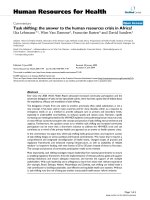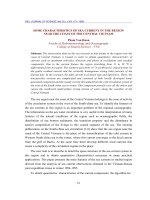Enhance the human resources quality in the Central Vietnam key economic zone
Bạn đang xem bản rút gọn của tài liệu. Xem và tải ngay bản đầy đủ của tài liệu tại đây (492.88 KB, 8 trang )
UEH-JED No.210 February 2012 | 37
Enhance the Human Resources Quality in the Central
Vietnam Key Economic Zone
BÙI QUANG BÌNH*
ABSTRACT
High-quality human resources play a very vital role in the national or regional economic
development and how to enhance the human resources quality has been a matter of concern to policymakers. The Central Vietnam Key Economic Zone (hereunder abbreviated as CVKEZ) has focused on
exploiting the human resources to accelerate the economic growth. Accordingly, the paper is to
evaluate the current situation in CVKEZ and recommend some measures to improve the human
resources quality in this zone in the near future.
Keywords: Human resources, human resources quality, enhance the human resources quality, Central
Vietnam Key Economic Zone
1. PROBLEM
The CVKEZ includes Thừa Thiên Huế, Đà Nẵng, Quảng Nam, Quảng Ngãi, Bình Định, Phú Yên,
and Khánh Hòa. It is located along the 800-km-long coastline of the Central Vietnam (accounting for
roughly 25% of Vietnam’s coastal line and territorial waters) with a population of roughly 8.1 million
people (equaling 9.4% of Vietnam’s population); these are two most important factors in the regional
economic development. However, in the past, this zone has just represented 8 to 10 percent of the GDP
and thus has not proved itself to be a key economic zone. What to do and how to develop the local
economy sustainably has really become a big question. Theories of economic development and
experiences from many countries show that high-quality human resources are the decisive factor. If the
high-quality human resources are well exploited in combination with marine advantages, the local
economy will surely take off. To enhance the quality of local human resources, therefore, is an urgent
matter.
2. HUMAN RESOURCES QUALITY
The human resources can be construed as the entire workforce of a country or a region; or in other
words, as physical and mental factors mobilized for the production process. The human resources are
represented in quality and quantity. The size of human resources can be defined as: (1) all physically
and mentally normal people, (2) working population of a society, or (3) all people in their working age
employed or unemployed (Phạm Đức Thành 1998). In this paper, the first definition is applied. The
quality of human resources has also long been mentioned for its vital role in the economic development.
As Adam Smith (1776) put it in his The Wealth of Nations, the greatest improvement in labor
productivity depends on the cleverness and creativity of workers, which may generate the national
* Associate Professor, Doctor of Philosophy, University of Economics – Đà Nẵng University,
Email:
38 | Bùi Quang Bình
Enhance the Human Resources Quality
wealth. Mankiw (2000) employs the labor effectiveness as a variable when analyzing the economic
growth; accordingly, he proves that the labor effectiveness reflects the workers’ knowledge of
production method and even health status, skills, and educational level, which are related to the quality
of human resources. The human resources quality often goes in line with the national population’s
quality because human resources, overall, are equal to the national population. If so, the quality of
human resources also includes the physical health, educational level, expertise, and competence of
workers (Phạm 1998).
The human resources quality is more reflected in terms of human capital, which plays an increasingly
important part in the economic development. As Mincer (1989) put it, human capital is the knowledge
needed for creativity - a basic component of economic development. Bùi Quang Bình (2009) points out
that human capital comprises knowledge, skills and experiences that are accumulated through a process
of learning, training, working, and employed in production process. Once workers bring their human
capital into production, it will benefit them. Seemingly, the workers’ health or physical condition is
implicit in human capital because a good health status must derive from an appropriate nutrition plan,
good living conditions, and regular physical exercise. This is to say, the quality of human resources and
the human capital seem to have the same connotation.
In sum, the human resources quality is all internal factors or workers’ overall capacity to fulfill tasks
effectively. It is comprised of education, physical status, expertise, and competence, etc. of workers; and
it will take time and long-term investment for these factors to be formed and accumulated.
The human resources quality takes a vital role in economic development, and this fact has been
emphasized in economic development models, which state that sustainable development requires an
accumulation of capital and technical and technological development. These factors attach to and
rely on the human resources quality. Once this quality is low or the human capital is so modest, the
generation and accumulation of capital as well as technical and technological development is
scarcely achievable. Micro- and macro-economic evidences have confirmed the important role of
human resources quality in economic development. Studies on the U.S. labor market have shown
that the average salary will rise 7.5% for each extra year of schooling (Acemoglu & Angrist 1999).
Caponi and Plesca (2007) point out that the income of university graduates is 30 to 40 percent
higher than that of high school ones. Some empirical evidence in Vietnam has also shown that per
capita GDP is directly proportional to number of schooling years (Trần Thọ Đạt 2008).
To enhance the human resources quality is very essential. Thus, besides improving the workers’
educational level and technical skills, enhancing their health and living conditions is also very necessary
(Phạm, 2008; Bùi, 2008, 2011). To do so, it is also advised to develop the health care and education
services, offer incentives to competent workers, and perfect the social welfare mechanisms.
3. QUALITY OF HUMAN RESOURCES IN CVKEZ
The structure and development of human resources of CVKEZ are exhibited in Figure 1. The right
vertical axis represents the ratio of baby boys to 100 baby girls (i.e. gender); and the left one reflects the
percentage of population rise, aging, and people in working age. The size of regional human resources
(apart from that of Đà Nẵng City) increase more slowly than the national average. In other words, the
UEH-JED No.210 February 2012 | 39
quantity of human resources will suffer a downward trend in the future. The ratio of working population
to the population in Đà Nẵng City is 67.7% which is higher than the national average of 66% (i.e. the
golden population ratio); meanwhile, that of remaining provinces is much lower that this golden ratio.
With regard to the aging ratio, except for Đà Nẵng and Khánh Hòa with an aging ratio lower than the
national average of 35%, other provinces suffer high aging ratios, especially Quảng Ngãi (45.7%) and
Quảng Nam (43.4%). This is to say, the working population of the zone is older than the national one.
The cause of this situation is the mass migration. The gender imbalance mainly takes place in three
provinces - Quảng Nam, Quảng Ngãi and Bình Định – where the ratio of baby boys to 100 baby girls is
higher than the national average and the standard ratio. The trend in human resources structure shows
that enrollment in elementary and junior high schools is falling and the working population is swelling.
Ratio of baby boys to 100
baby girls
Annual population rise (%)
Working population (%)
Ratio of aging population (%)
Vietnam
Figure 1: The quantity and structure of human resources in CVKEZ
Source: GSO 2009 census
Ratio of new
Ratio of
habitants
migrants
Ratio of net migration
Figure 2: Migration in CVKEZ
Source: GSO 2009 census
40 | Bùi Quang Bình
Enhance the Human Resources Quality
Figure 2 shows that the migration ratio in CVKEZ (except for Đà Nẵng) is very high. According to
Figures 1 and 2, provinces with high ratio of net migration or high ratio of migrants will suffer a high
aging ratio and a low percentage of working population. Visibly, migration has been adversely affecting
the human resources structure of the zone. Migration can be explained by the fact that people hope to
find better employment opportunities and personal incomes in other zones.
The next part provides a closer look on human resources quality in CVKEZ. We will start with the
physical status (i.e. the ratio of physically or mentally disabled people which puts a strong pressure on
the society). The ratio of physically or mentally disabled people in CVKEZ is higher than the national
average (4.9%); the lowest ratio is found in Phú Yên (5.66%) and the highest ones are in Quảng Nam (7.59%), Quảng Ngãi (-7.19%), and Bình Định (-7.23%). This can be explained by the fact that these
provinces are adversedly affected by the war and problems in the aftermath of the war. Additionally,
ensuring health care and social welfare is also much needed.
Vietnam
Literacy among residents aged 15 and above
Ratio of elementary school graduates
Ratio of junior high school graduates
Ratio of senior high school graduates or higher
Figure 3: The educational level of human resources in CVKEZ
Source: GSO 2009 census
The educational level of human resources in CVKEZ, as exhibited in Figure 3, is not evenly
distributed among provinces and not much different from the national average. The literacy ratio of
Thừa Thiên Huế and Quảng Ngãi is lower than the national average while the highest ratio in the zone is
found in Đà Nẵng. Besides, the ratio of elementary school graduates of all provinces in CVKEZ (apart
from Đà Nẵng) is higher than the national average; yet the ratio of senior and junior high school
graduates is much lower (except for Đà Nẵng with higher ratio of junior high school graduates). In sum,
given this structure, the educational level of all provinces in the zone (save Đà Nẵng) is much lower
than the national average. Hence, provinces in the zone should pay fuller attention to universalization of
and improvements in the general education system to enhance the quality of this service.
The education of human resources in CVKEZ is presented in Figure 4. The number of professionally
trained and certified workers in the zone (save Đà Nẵng) is lower than the national average. Moreover,
there is also a great gap between Đà Nẵng and remaining provinces; the ratio of workers with a
university degree in Đà Nẵng is much higher than that of its neighbors. Therefore, the zone is facing an
imbalance in vocational training that leads to a surplus of white-collar workers and a shortage of blue-
UEH-JED No.210 February 2012 | 41
collar ones. Given Figures 2, 4 and 5, it is possible to state that the impact of migration on educational
level and vocational training of human resources in the region is very strong and negative.
Vietnam
Ratio of workers with a
university degree or higher
Ratio of workers graduating
Ratio of workers with elementary certificates
Ratio of workers with 3-year college degrees
from technical high schools
Figure 4: The ratio of professionally trained human resources
Source: GSO 2009 census
Figure 5 reflects the structure of human resources by economic sectors (i.e. manufacturing and
construction, service, and agriculture). This structure in its turn can reflect the human resources quality
because the educational level and technical skills of workers are the basis for the labor allocation. In Đà
Nẵng, the ratio of agricultural workers is just 9.9%, lowest in the zone, followed by Thừa Thiên Huế
(37.1%) and Khánh Hòa (40.1%). Meanwhile, in the remaining provinces, this ratio is higher than the
national average of 51.8%. The more technical training the workers obtain, the more employment
opportunities in non-agricultural sectors are offered to them. The development of human resources goes
in line with radical changes in the labor structure; and therefore to expedite the changes in economic
structure, it is necessary to enhance the human resources quality.
Ratio of workers in service sector
Ratio of workers in manufacturing
and construction sector
Ratio of workers in agriculture,
forestry and sea farming
Vietnam
Figure 5: Allocation of human resources by economic sectors in CVKEZ
Source: GSO 2009 census
42 | Bùi Quang Bình
Enhance the Human Resources Quality
Above analyses show that there are many problems with the human resources in CVKEZ. The
followings are some of them.
- The rise in the size of human resources has been fallen when the birth ratio is just 2.15 babies per
woman and the population density in the zone is much lower than the national average.
- The aging pace of the human resources is faster than the national average; the gender imbalance is
more serious and the size of working population is contracting.
- Outbound migration keeps rising and adversely affects the human resources structure in CVKEZ.
- The ratio of physically or mentally disabled human resources is quite high and shows no sign of
decline.
- The educational level and technical skills of human resources in CVKEZ are not evenly distributed
and much lower than that of the national average.
- The labor structure is very different over provinces and usually more backward than the national
standards.
4. MEASURES TO ENHANCE THE HUMAN RESOURCES QUALITY IN CVKEZ
a. Create a close cooperation among provinces in CVKEZ for socioeconomic and human
resource development:
There should be a common socioeconomic development strategy for the whole zone. Labor
allocation and intensive specialization should be carried out among provinces to make the best use of
human resources and local potential advantages. It is also necessary to ensure the balance between labor
and other factor inputs. Besides, the establishment of towns will pave the way for the birth of economic
hubs in rural areas which will attract rural workers.
Each province should equip itself with an appropriate economic structure which can facilitate the
quick growth and promote the development of human resources; and simultaneously zone the territory
scientifically. At present, most provinces in CVKEZ have the same orientations in economic
development and transition (i.e. develop the industries of textile and garment, agricultural products
procession, etc.), which can result in shortage of inputs and even unfair competition.
It is advised to develop small-sized industrial estates, small and medium-sized enterprises in rural
areas, maintain and expand non-agricultural sectors to create more jobs, and improve the income of rural
workers.
At present, there are tens of universities, colleges and vocational training schools in CVKEZ, which
can produce high-quality human resources for the zone. However, they are not evenly allocated and
mainly located in Đà Nẵng and Thừa Thiên Huế. Thus, a close cooperation among provinces in CVKEZ
will enable poor provinces to develop their training system.
In the context of an immature market for science and technology, provinces can outsource
technological and administrative experts; and help local schools connect research and training.
b. Adjust policies on population and family planning:
UEH-JED No.210 February 2012 | 43
Instead of curbing the population rise, it is advised to focus on enhancing the human resources
quality, and improve the quality of social services in order to take good care of pregnant mothers and
babies and prevent malnutrition.
Continue to maintain and accelerate the family planning program in the direction of minimizing
gender interventions and ensuring the gender balance, and in combination with widespread propagation,
especially in remote and depressed areas.
c. Perfect the health care system:
In order to improve the physical status of human resources, it is necessary to boost the workers’
income by guaranteeing a stable livelihood and social equality, and enabling children of poor families to
access services of health care and education. Other necessary measures are to continue to improve and
expand health care centers in remote areas; guarantee the sufficient number of doctors and nurses;
implement effectively programs such as preventive medicine, epidemic prevention, anti-malaria,
counter-malnutrition for under-fives, pregnant mothers care, family planning, etc.; and improve
Vietnam’s physical status via nutritional measures and physical exercises.
d. Improve the quality of educational programs:
For general education, it is necessary to renovate the curriculums and teaching and learning methods
by making the young generation confident, creative, responsible and able to meet requirements of
socioeconomic development. Teaching must accompany with job orientation. Additionally, it is
important to increase investments in education, train qualified teaching staff, and universalize general
education.
For tertiary education, academic programs, textbooks and facilities should be standardized to serve
socioeconomic development. Moreover, the quality of lecturing staff and students must be strengthened;
teaching should go in line with scientific research; and educational management and international
collaboration should also be improved.
For vocational training systems, the academic programs should be standardized. Vocational training
should meet demand for local development. The local authorities should support vocational training,
regard it as a development investment, and encourage public participation in this service. At present,
implementing effectively vocational training programs for rural workers and young adults is crucial.
e. Work out policies on recruitment, employment, incentives, and selecting:
This is a decisive task for the development of human resources. According to both local and foreign
experiences, the human resources will barely develop without a reasonable policy on labor at both
macro and micro levels.
Recruitment policy should define criteria for choosing appropriate candidates for a particular job.
When recruiting, job performance should be prioritized without any prerogative for any personal
relation; publicize recruitment procedures, criteria, working conditions, and incentives. In case there is
no qualified recruiter, it is possible to outsource consultants and employ the probation regime.
Matching workers with their skills will help individuals manifest their competence; and more
importantly, encourage them to perfect themselves. Local authorities can hire experts in universities or
research institutes to consult and renovate the technology, production line and managerial mechanism.
44 | Bùi Quang Bình
Enhance the Human Resources Quality
Results from application of technical or managerial advances can be turned into financial support for
future researches.
Workers should be provided with reasonable salary, bonuses, incentives, working conditions and
promotion opportunity to make them attach themselves to the job and willingly improve their
competence.
Workers who cannot meet work requirements must be dismissed to enable other candidates to
perform their capacity. This is also an indispensable part of development that forces workers to perfect
themselves continuously.
All these elements are closely connected in a comprehensive policy. However, such policies have not
been well implemented. Provinces have introduced various measures to attract high-quality human
resources; yet if the local high-quality human resources have not been employed or enabled to develop,
such measures will never work. Perhaps, local authorities should ask themselves why many of welltrained workers refuse to work in their native town.
f. Perfect the social welfare system:
The social welfare system together with its components such as social insurance (i.e. old-age
pension, unemployment insurance, compulsory health insurance, etc.), social relief, subsidies financed
by public funds, contingency reserves, labor protection policy, social security services, etc. will help
people make the best use of their human rights, and have a peaceful life. They are protected by law and
have the right to go to school, have a job, buy a dwelling house; and are secured with basic necessities,
etc. A well-organized social welfare system will definitely contribute tremendously to the human
resources quality in the region.
All these measures have a mutual effect and thus should be synchronously undertaken
References
Acemoglu, D. & J. Angrist (1999), “How Large Are the Social Returns to Education? Evidence from Compulsory
Schooling Laws”, NBER Working Paper No.7444.
Bùi Quang Bình (2008), “Vốn con người và thu nhập của hộ sản xuất cà phê ở Tây Nguyên” (Human capital and
income of coffee cultivators in Tây Nguyên), Khoa học và Công nghệ, Đà Nẵng University, No.4 (27).
Caponi V. & M. Plesca (2007), “Post-Secondary Education in Canada: Can Ability Bias Explain the Earnings Gap
between College and University Graduates?”, IZA Discussion Paper No.2784.
GSO (2011), Niên giám thống kê Việt Nam 2010 (Vietnam’s Statistical Yearbook 2010), Thống Kê Publisher.
Mankiw, N. G. (2000), Macroeconomics, 2nd Ed., Harvard University, Worth Publishers.
Mincer, J. (1989), Job Training: Costs, Returns, and Wage Profiles, Columbia University Press.
Phạm Đức Thành (1998), Kinh tế Lao động (Labor Economics), Giáo dục Publisher
Trần Thọ Đạt, et al. (2008), “Tác động của vốn con người tới tăng trưởng kinh tế của các tỉnh và thành phố Việt
Nam giai đoạn 2000 – 2006”, Kinh tế và Phát triển, No.138.









